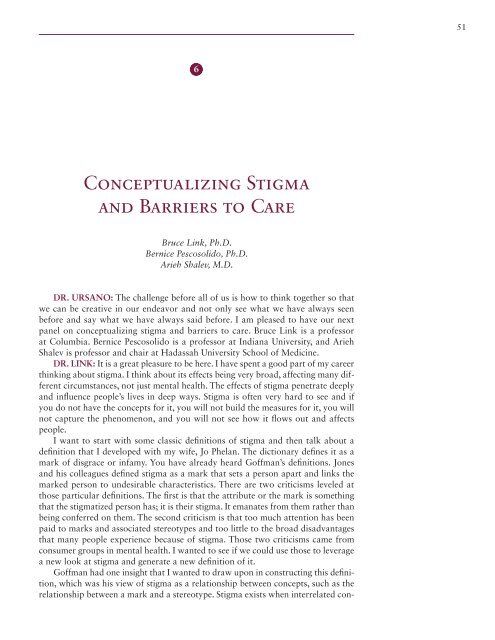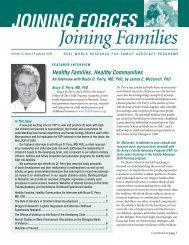stigma and barriers to care - Uniformed Services University of the ...
stigma and barriers to care - Uniformed Services University of the ...
stigma and barriers to care - Uniformed Services University of the ...
You also want an ePaper? Increase the reach of your titles
YUMPU automatically turns print PDFs into web optimized ePapers that Google loves.
Conceptualizing Stigma <strong>and</strong> Barriers <strong>to</strong> Care 51<br />
6<br />
Conceptualizing Stigma<br />
<strong>and</strong> Barriers <strong>to</strong> Care<br />
Bruce Link, Ph.D.<br />
Bernice Pescosolido, Ph.D.<br />
Arieh Shalev, M.D.<br />
DR. URSANO: The challenge before all <strong>of</strong> us is how <strong>to</strong> think <strong>to</strong>ge<strong>the</strong>r so that<br />
we can be creative in our endeavor <strong>and</strong> not only see what we have always seen<br />
before <strong>and</strong> say what we have always said before. I am pleased <strong>to</strong> have our next<br />
panel on conceptualizing <strong>stigma</strong> <strong>and</strong> <strong>barriers</strong> <strong>to</strong> <strong>care</strong>. Bruce Link is a pr<strong>of</strong>essor<br />
at Columbia. Bernice Pescosolido is a pr<strong>of</strong>essor at Indiana <strong>University</strong>, <strong>and</strong> Arieh<br />
Shalev is pr<strong>of</strong>essor <strong>and</strong> chair at Hadassah <strong>University</strong> School <strong>of</strong> Medicine.<br />
DR. LINK: It is a great pleasure <strong>to</strong> be here. I have spent a good part <strong>of</strong> my <strong>care</strong>er<br />
thinking about <strong>stigma</strong>. I think about its effects being very broad, affecting many different<br />
circumstances, not just mental health. The effects <strong>of</strong> <strong>stigma</strong> penetrate deeply<br />
<strong>and</strong> influence people’s lives in deep ways. Stigma is <strong>of</strong>ten very hard <strong>to</strong> see <strong>and</strong> if<br />
you do not have <strong>the</strong> concepts for it, you will not build <strong>the</strong> measures for it, you will<br />
not capture <strong>the</strong> phenomenon, <strong>and</strong> you will not see how it flows out <strong>and</strong> affects<br />
people.<br />
I want <strong>to</strong> start with some classic definitions <strong>of</strong> <strong>stigma</strong> <strong>and</strong> <strong>the</strong>n talk about a<br />
definition that I developed with my wife, Jo Phelan. The dictionary defines it as a<br />
mark <strong>of</strong> disgrace or infamy. You have already heard G<strong>of</strong>fman’s definitions. Jones<br />
<strong>and</strong> his colleagues defined <strong>stigma</strong> as a mark that sets a person apart <strong>and</strong> links <strong>the</strong><br />
marked person <strong>to</strong> undesirable characteristics. There are two criticisms leveled at<br />
those particular definitions. The first is that <strong>the</strong> attribute or <strong>the</strong> mark is something<br />
that <strong>the</strong> <strong>stigma</strong>tized person has; it is <strong>the</strong>ir <strong>stigma</strong>. It emanates from <strong>the</strong>m ra<strong>the</strong>r than<br />
being conferred on <strong>the</strong>m. The second criticism is that <strong>to</strong>o much attention has been<br />
paid <strong>to</strong> marks <strong>and</strong> associated stereotypes <strong>and</strong> <strong>to</strong>o little <strong>to</strong> <strong>the</strong> broad disadvantages<br />
that many people experience because <strong>of</strong> <strong>stigma</strong>. Those two criticisms came from<br />
consumer groups in mental health. I wanted <strong>to</strong> see if we could use those <strong>to</strong> leverage<br />
a new look at <strong>stigma</strong> <strong>and</strong> generate a new definition <strong>of</strong> it.<br />
G<strong>of</strong>fman had one insight that I wanted <strong>to</strong> draw upon in constructing this definition,<br />
which was his view <strong>of</strong> <strong>stigma</strong> as a relationship between concepts, such as <strong>the</strong><br />
relationship between a mark <strong>and</strong> a stereotype. Stigma exists when interrelated con-




